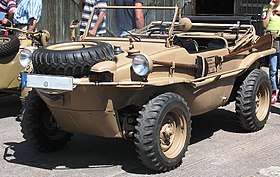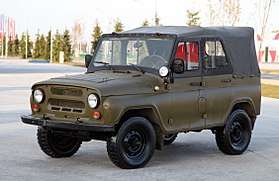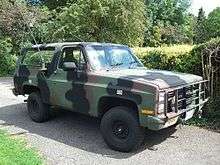Military light utility vehicle
.jpg)
Military light utility vehicle, or within military context or parlance just Light Utility Vehicle (LUV), is a term sometimes used for the lightest weight class military vehicle category.[1] In popular terms, what is intended is a jeep-like, typically four-wheel drive vehicle for military use.[2] They are by definition lighter than other military trucks and vehicles, inherently compact and usually unarmored, with short body overhangs for nimble all-terrain mobility, and frequently around 4 passenger capacity.
Worldwide, and since the earliest large scale mechanisation of the military, hundreds of different light vehicles have been used for military utility service, ranging from readily available commercial products, just repainted in military colors, to purpose-designed tactical vehicles, that where specially developed for military applications and operation in forward areas. Light utility vehicles are typically general or multi-purpose – used to carry troops, staff, (mounted) weapons, supplies, evacuate wounded soldiers and many other diverse roles.[2]
Historically originated in the first half of the twentieth century, when modernisation of armies meant replacing horses and other draft animals through mechanisation, as well as increasing mobility of the infantry, to gain an essential tactical advantage, the nature and operating circumstances for the military's lightest utility vehicles have since changed. In 21st century missions, small arms fire and improvised explosive devices (IEDs) continuously pose highly dangerous threats to mobile infantry, and the military's lightest utility vehicles have frequently become heavier and larger, as a result of addition of armor, for the purpose of crew protection.[3] Designs for modern light military vehicle platforms have to balance manoeuvrability, speed, weapons capability, survivability and transportability – all of high importance to ground troops in operations.[3]
Civilian adaptations of the Willys MB Jeep and Land Rover were the first sport utility vehicles, and some SUVs such as the Chevy Blazer have been used as military light utility vehicles.
The importance of this kind of military vehicle was summed up by General Eisenhower, who wrote that most senior officers regarded the jeep as one of the six most vital U.S. vehicles in World War II.[5] Moreover, general George Marshall called the jeep “America’s greatest contribution to modern warfare.”[6][7][8] Similar vehicles are among the most common military vehicles in armies of most nations.
World War II

In 1939 the U.S. Army began standardizing its general-purpose trucks by limiting procurement to five chassis payload classes, from 1⁄2-ton to 7 1⁄2-ton, but the army was "to use commercial trucks with only a few modifications such as brush guards and towing pintles .." [9] However, in 1940 the categories were revised. A new, lightest chassis, quarter-ton class was introduced, at the bottom of the range, and the 1⁄2-ton category was supplanted by a 3⁄4-ton chassis — both were classified as light trucks; 1 1⁄2-tonners were considered medium. [10]
The Willys MB Jeep of World War II used by the U.S. Army is probably the most widely known vehicle of this class. Over 640,000 Jeeps were built for World War II, and they inspired many vehicles similar in layout, or function. Besides the jeep, the U.S. also produced some 330,000 half- and three quarter-ton Dodge WC series trucks, in a wide range of variants. Together, the Willys and Ford jeeps, and Dodge's WC-series trucks made up nearly all of the WW II U.S. light vehicle output of almost a million (~988,000) units.[11][10]
In World War II, Germany used the Volkswagen Kübelwagen for a similar role. It only had rear-wheel drive, but could take advantage of light weight, a very flat, smooth underbody,[12] rear axle portal geared hubs, and a rear-mounted engine for mobility. Early American dune buggies were also based on the Volkswagen, and the Desert Storm-era Desert Patrol Vehicle evolved from the dune buggy configuration for combat use.
The Volkswagen Schwimmwagen featured a bathtub-like unitary boat-body and propulsion screw. The Jeep was similarly adapted as the Ford GPA "Seep", but was never as successful as the Schwimmwagen, which became the most mass-produced amphibious car in history. Contrary to the regular German Kübelwagen, the Schwimmwagen was equipped with four-wheel drive, and with its super-smooth underbody and portal geared hubs front and rear, arguably the most capable light German off-roader in World War II.
The Soviet Union produced the GAZ-64 based largely on the US jeep design, succeeded by the GAZ-67 and GAZ-67B, until ca. 1953.
Post-war


The U.S. revised its jeep into the Willys M38 and M38A1, which was used in the Korean War. It was followed in 1960 by the M151 jeep, which was designed with Ford. By the mid-1980s, this role would be taken over by the larger and heavier Humvee, which would be used as a combat vehicle in Iraq. The United States also purchased Commercial Utility Cargo Vehicles based on commercially available light trucks. U.S. forces are currently defining the Joint Light Tactical Vehicle which would be designed to be armored from the outset, with the smallest 4-person payload capacity class corresponding to the traditional jeep role.
In 1948, the British Land Rover was developed. Originally intended to be a civilian and agricultural successor to the Willys Jeep (the prototype Land Rover was built on the chassis of a Willys and used Willys transmission parts but production vehicles used no Jeep components) the Land Rover was brought into military service in 1949, becoming the standard Light Utility Vehicle for the British Army and many armed forces of the Commonwealth. The original Land Rover design evolved into the modern-day Land Rover Defender which is still in military service throughout the world.
About 1953 Russia replaced its GAZ-67B by the GAZ-69, until that series was replaced by the UAZ-469 commander jeep which was introduced in 1971.
In the 1960s, China's Beijing Automobile Works produced its own "jeep", the Beijing BJ212 which was largely a Chinese copy of the Soviet UAZ-469B. Often called the “Beijing Jeep”, the BJ121 was widely used in both military and civilian service in China, with over 200,000 produced by end of production in 1983. In May 1983, American Motors Corporation (AMC) agreed to allow the updated BJ2020S to use the 85 hp engine of the XJ Jeep Cherokee.[13] The latest Chinese light utility will be the BJ2022JC 'Brave Warrior', built by Beijing Benz-DaimlerChrysler Automobile Co. Adapted from existing Mercedes Benz designs, the BJ2022JC will carry 0.7 ton, with a wheelbase of 110 inches, and has an independent suspension system with a 101.5 kW 3.2 L turbo-charged inter-cooling diesel engine.[14]
In 2014, Boeing and MSI Design designed the Phantom Badger, in response to the aging Humvee fleet, which was too large for newer aircraft to feasibly carry.[15]
HMMWV-like vehicles
The HMMWV platform represented a paradigm change in the U.S. military — abolishing the dichotomy between the small quarter-ton rigs, and the various other, larger "light" trucks, after more than four decades. Intended to replace all of the Army's 1⁄4-ton to 1 1⁄4-ton vehicles with one single chassis, the resulting 1⁄4-ton Humvee became much larger and heavier than the jeeps, and inspired a new generation of vehicles, used in similar military roles.
- GAZ-2975 "Tigr" - Russian Military HMMWV currently in service
- Toyota built a vehicle largely derived from the HMMWV design with a similar design and layout called the Mega Cruiser. Toyota produced a military version of the Mega Cruiser, named the Koukidousya, that is in service with the Japan Self Defense Forces.
- Iveco LMV
- China produces three vehicles based on HMMWV with varying degrees of cooperation with the original manufacturer.
- Uro of Spain builds the VAMTAC.
- Agrale Marruá
- VLEGA Gaucho
- Kharkiv Morozov Machine Building Design Bureau of the Ukraine builds the Dozor-A.
- MOWAG Eagle
- Marine Multi-Purpose Vehicle (MMPV) by Philippine Marine Corps
Notes
- ↑ Hope, Claire (July 2008). Light Utility Vehicles 2008 (announcement). allconferences.com. Defense IQ Press. Archived from the original on 2008-09-08. Retrieved 20 July 2008.
to be discussed at this international event will include (...) the U.S. Joint Light Tactical Vehicle replacement programme
- 1 2 Top 10 Military Light Utility Vehicles – Military Today.com
- 1 2 Determining the Requirements for the 21st Century Utility Fleet. Light Utility Vehicles 2008. London, UK: Defense IQ, IQPC. 8–9 July 2008. Archived from the original
|archive-url=requires|url=(help) on 2008-07-04.Addressing Key Issues for the LUV Class
|access-date=requires|url=(help) - ↑ Dwight D. Eisenhower (1948). Crusade in Europe. Doubleday (US) / Heinemann (UK). p. 163/164. ISBN 080185668X. OCLC 394251.
- ↑ The others being the bulldozer, the Landing Ship, Tank, the amphibious "Duck" truck, the 2½-ton 6x6 truck, and the C-47 airplane.[4]
- ↑ Foster, Patrick R. (2014). Jeep: The History of America's Greatest Vehicle. Motorbooks. p. 11. ISBN 9780760345856. Retrieved 30 January 2018.
- ↑ "The Jeep: An American Icon". National Museum of the United States Army. 16 July 2012. Retrieved 27 January 2018.
- ↑ Bennett, Ralph Kinney (9 April 2010). "The Elegant Jeep". American Enterprise Institute. Retrieved 27 January 2018.
- ↑ Thomson, Harry C.; Mayo, Lida (2003). The Ordnance Department: procurement and supply. Washington, D.C.: Center of Military History, U.S. Army (Originally published: 1960, Washington, D.C., Office of the Chief of Military History, Dept. of the Army). p. 269/270.
- 1 2 Hyde, Charles K. (2013). Arsenal of Democracy: The American Automobile Industry in World War II. Wayne State University Press. pp. 147–148, 152. ISBN 9780814339527.
- ↑ Thomson & Mayo (2003), p. 296.
- ↑ thanks to its VW Beetle-like platform chassis instead of a ladder-frame
- ↑ BJ2020S 0.5t Light Utility Vehicle Archived 2008-07-20 at the Wayback Machine.
- ↑ China's PLA plans Brave Warrior light utility vehicle buy Jane's Defence Weekly Aug 08, 2007
- ↑ https://www.wired.com/2014/04/navy-phantom-badger/